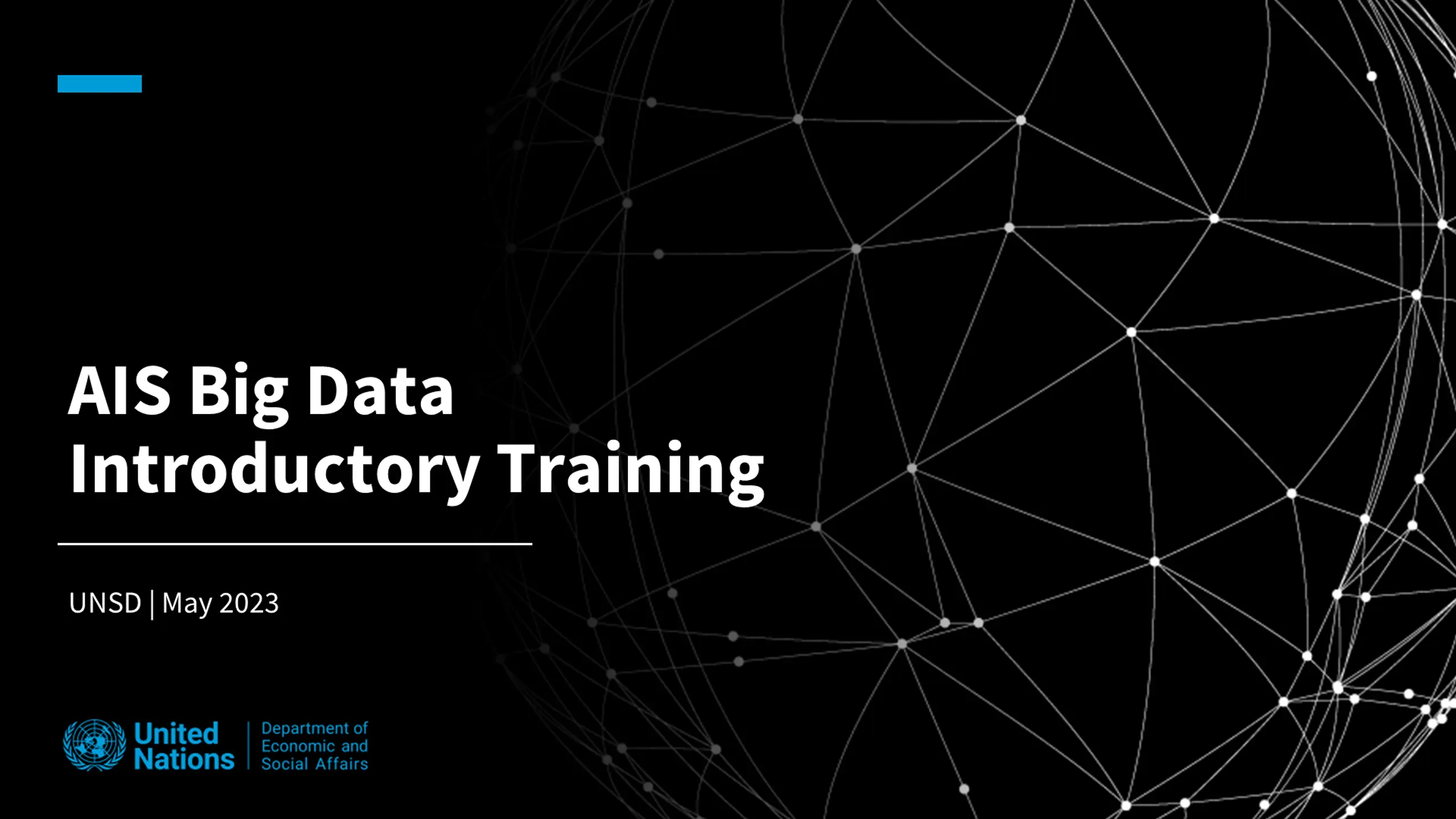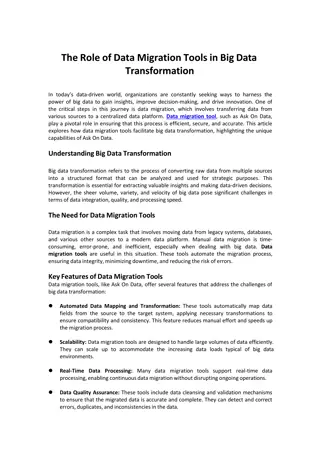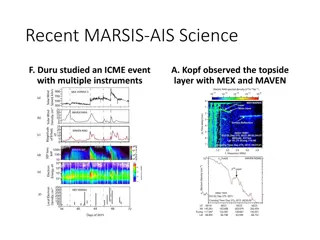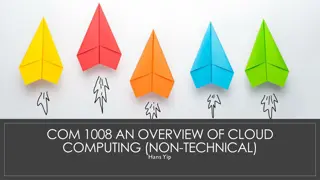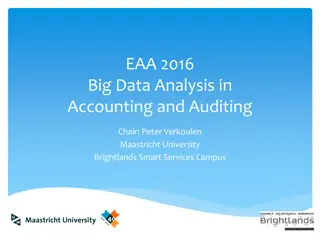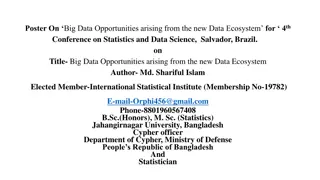AIS Big Data Introductory Training | May 2023
Join our AIS Big Data Introductory Training in May 2023 and learn about AIS data generation, accessibility, use cases, acquiring AIS data, and more.
Download Presentation

Please find below an Image/Link to download the presentation.
The content on the website is provided AS IS for your information and personal use only. It may not be sold, licensed, or shared on other websites without obtaining consent from the author.If you encounter any issues during the download, it is possible that the publisher has removed the file from their server.
You are allowed to download the files provided on this website for personal or commercial use, subject to the condition that they are used lawfully. All files are the property of their respective owners.
The content on the website is provided AS IS for your information and personal use only. It may not be sold, licensed, or shared on other websites without obtaining consent from the author.
E N D
Presentation Transcript
AIS Big Data Introductory Training UNSD | May 2023
Outline Overview o What is AIS Data o AIS Data generation o Accessibility of AIS data AIS Data Use Cases Acquiring AIS Data Useful recourse and learning opportunities
About AIS The Automatic Identification System (AIS) is an automated, autonomous tracking system which can be used for the exchange of navigational information between AIS-equipped terminals. It allows vessels like cargo ship, tanker, fishing vessel or passenger ship to periodically broadcast their information. AIS was originally developed by IMO (International Maritime Organization) in 2004, solely for collision avoidance among large vessels at sea that are not within range of shore-based systems. Now, AIS data provides a big data source of unrivaled quality above and beyond its original application for collision avoidance.
About AIS Big Data The system stores more than 11 million AIS messages a day There are 27 different AIS messages containing different types of information AIS data mainly comprised of 3 information categories, which are Static data, dynamic data, and voyage-related data. Static data Dynamic data information on ship characteristics position and movements Voyage-related data information on a current voyage information on ship MMSI, IMO number, call sign, ship name, type, dimensions Ship s position (long, lat), speed over ground (SOG), course over ground (COG), navigation status Destination, estimated time of arrival, drought (Time does not exist in AIS frames. It is added by receivers)
AIS Data example Vessel ID Vessel name Vessels Type Vessels Size Vessels Flag
AIS Data example Geospatial location Navigation Status Destination Speed
AIS Data example Source Time
How it works Static information & voyage related information: are provided by the crew of the vessel and is transmitted every 6 minutes Dynamic information: is automatically transmitted depending on the vessels' speed and course while underway every 2 to 10 seconds and while a vessel is at anchor every 3 minutes
Accessibility of AIS Data How to get the data? As the use and demand of AIS data have increased, this enabled the rise of AIS data provider(s) that collect, store, analyze and disseminate AIS data. Commercial data providers offer access to AIS data that they have collected and enriched, but the costs could be significant UN Global Platform: UNSD acquires AIS data from commercial data providers Makes it available via the UN Global Platform It is free for experimental and official statistics use and it is accessible around the globe UN Global Platform provides the storage and computing functionality that required to work with big data
Other AIS data providers AIS data community: AIS Data Exchange Hub (https://www.aishub.net/) Government: Norwegian Coastal Administration (https://kystverket.no/) US Coast Guard: (https://marinecadastre.gov/ais/) Commercial Providers: MarineTraffic (https://www.marinetraffic.com) ExactEarth (https://www.exactearth.com/)
General uses of AIS data AIS data can be used for: Maritime applications: Navigation at sea, collision avoidance at sea, search and rescue, accident investigation, Tracking and monitoring: Port monitoring, fleet and cargo tracking International trade: International trade estimation, economic trend discovery Environmental statistics: Shipping greenhouse gas emission estimation, ocean currents estimation
Which field are you interested in? Start presenting to display the poll results on this slide.
IMF Trade volume estimates Research question: if theAIS data can be used for trade volume estimation. Enable statistical agencies to complement existing data sources on trade and introduce more timely (real-time) new statistics that measure trade flows. Research uses Malta as a benchmark A) Cargo number indicator: - Number of cargo ships visiting a port (filtered) - Comparable with official number of ships B) Cargo load indicator: - Volume of cargo loaded/unloaded at a port - Highly correlated with the official trade in volume Conclusion: trade in goods, trade volume, gross trade, and trade by broad groups can be measured with the AIS data.
UK ONS Fastereconomicindicators Research question: Can we use AIS data to create faster economic indicators, enabling Policy makers to act more quickly? Research undertaken: Three economic/trade indicators have been developed: 1. Time-in-port aggregated time in seconds spent by ships in UK ports 2. Port traffic number of unique ships (MMSI) entering port 3. Number of visits/port calls, e.g. to capture multiple sailing, e.g. ferry route Future research: Disaggregate Time-in-port by duration of stay Anchorage or holding area outside port might contain information, e.g. holding pattern indicating port congestion, increasing oil prices, etc.
Greenhouse Gas Study (Fourth IMO) Uses AIS data to track and calculate a ship s emissions: a) Movement of ships b) Port calls c) Speed d) Ships characteristics Merged with other data on engine type, fuel oil consumption and power demand Can provide an estimate of a ship s emissions Can distinguish between domestic and international emissions -> more accurate international shipping emissions Resulting emissions estimates for each ship are aggregated into annual statistics, broken down by domestic and international voyage, vessel types, and size categories
Port monitoring: PORTWATCH Port Monitor | PortWatch (arcgis.com)
Environmental statistics:Panama Canal case stats.mtcclatinamerica.com
UN Global Platform for AIS Platform Services REST API GitLab Data Users Data Computing Spark Executor Kubernetes master Scheduler API Server Spark Executor Spark Driver Spark Executor Data Storage S3 Buckets Data Aggregation Satellite Network terrestrial-based Receiver network +
UN Global Platform Overview Link: https://id.officialstatistics.org/
UN Global Platform: Code Service Link: https://code.officialstatistics.org/
UN Global Platform: Notebook Service Link: https://aaw.officialstatistics.org/hub/spawn *Jupyterhub: a browser-based remote computing environment.
Example of acquiring AIS data JupyterHub (officialstatistics.org)
AIS Data format Format:Data is converted toparquetformat. Every parquet is partitioned by H3 index resolution 0. H3 index : Hexagonal hierarchal spatial index Global grid system developed by Uber Engineering Each latitude and longitude pair is transformed to a 64-bit H3 index identifying a grid cell Resolution 0: Ave. area of ~4.2Mn sq.km Ave. hexagon edge length ~1,107km 122 unique indices Resolution 15 Ave. area of 9xe-7 sq. km Ave. hexagon edge length 0.5m 569 trillion unique indices Image source: Uber
AIS Data Strength & Weaknesses Strengths Timely statistics can be generated Aggregated data can be filtered High frequency data Weaknesses Not consistent in some areas and from some vessel sizes (missing data) Vessels can switch off the device e.g. in piracy areas Manually input data is based on crew proactivity in timely updating
Useful Resources and Learning Opportunities
Learning Opportunities AIS handbook: https://unstats.un.org/wiki/display/AIS/AIS+Handbook AIS E-learning course: https://learning.officialstatistics.org/course/index.php?categoryi d=8 AIS Online Sprint: 1 week training in September
Useful Resources Official website: https://unstats.un.org/bigdata/task-teams/ais/index.cshtml Use cases: Fourth Greenhouse Gas Study 2020 (imo.org) Big Data on Vessel Traffic: Nowcasting Trade Flows in Real Time (imf.org) Faster indicators of UK economic activity: more timely and relevant shipping indicators | Data Science Campus (ons.gov.uk) AIS Big Data Hackathon: Winning project: AIS Hackathon UN-CEBD Apache Spark: https://spark.apache.org/
How to request access USERemails USER support@officialstatistics.org support@officialstatistics.org to request for AIS Data Platform access through UNGP. User must provide the following information: Full name: Email address: Nationality: Details on your use of AIS: receive a welcome email and activation link. User activate the account SUPPORT TEAM SUPPORT TEAM SUPPORT TEAM creates accounts on UNGP and send invitation to the user to join AIS Task Team receives and reviews request requests USER to fill-out the form at: https://forms.office. com/r/0k1QBZunKe for tracking Start Finish
Q&A Do you have additional questions?
